JIU Josai International University

40 fourth-year students participated in an overnight training on the themes of "food" and "public health activities"
Faculty Department
2023.07.04
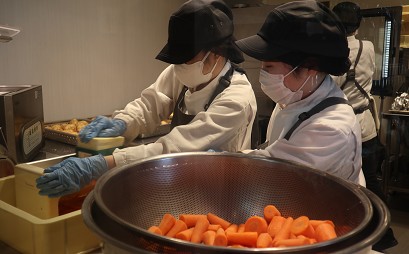
At the restaurant of "Fukaya Terrace Yasai na Nakamatachi Farm", try preparing the vegetables that will be served at lunch
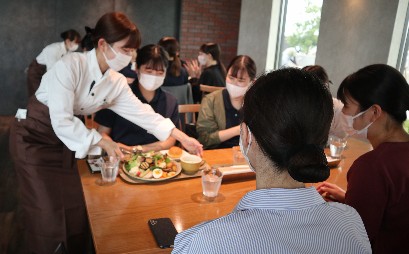
At lunch, take turns serving customers and learn how to be considerate of others
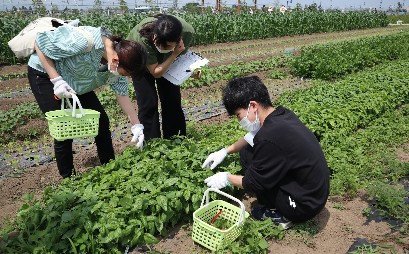
Harvesting vegetables guided by the student guide (center) at the hands-on farm
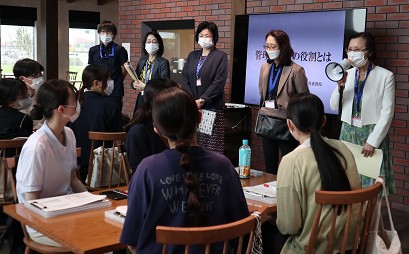
Teachers from the Faculty of Nutrition, Toto University introducing themselves to the students
A training program was held in Saitama Prefecture and Tokyo for 40 fourth-year students of Faculty of Nursing Department of Nursing, who aim to acquire public health nurse qualifications together with nurses. As part of the "Public Health Nursing Activity Theory Seminar", students acquired the knowledge necessary for health education in the field of "food" and learned about public health activities as health crisis management, using tuberculosis as an example. For students who entered their final year without being able to attend the compulsory domestic and international training due to the effects of the coronavirus pandemic, it was a valuable opportunity to learn not only knowledge but also bonds with friends. We had a deep relationship.
On the first day, June 1st, a training session on the theme of "food" was held at "Fukaya Terrace Yasai na Nakamatachi Farm" in Fukaya City, Saitama Prefecture. Established by Kewpie Corporation (Shibuya-ku, Tokyo), this facility has a hands-on farm, market, vegetable classes, restaurants, and more. Through this experience, you can learn the importance of cooking, serving, and having fun. The students were rotated into groups and not only received the service, but also had a special experience on the side of the provider.
At the hands-on farm, the students in charge of each type of vegetable, such as zucchini and coriander, acted as explanations and supported the students harvesting. At the restaurant, the students in charge of cooking experienced the preparation and presentation of vegetables, while the students in charge of the hall staff took turns serving lunch. When you are on the service side, you will receive a lecture from the facility staff on the nutritional value of vegetables, cooking methods, and points for customer service, and you will immediately put that knowledge into practice on the spot. When I was on the "customer" side, I learned what kind of explanations would be easy to understand and how to interact with them so that I could communicate well.
In the second half, five faculty members from the Faculty of Nutrition, Toto University, which has a campus in Fukaya City, came to give lectures on the nutritional knowledge necessary to work as a public health nurse. Associate Professor Toshiko Sato explained the role of registered dietitians who provide nutritional guidance at hospitals and schools, and emphasized the importance of the cooperation of nurses and public health nurses in supporting the health of patients and children from a nutritional perspective. I told you. In addition, Lecturer Noriko Koitani explained the role of registered dietitians in community nutrition activities centered on public health centers, and Lecturer Masako Sasaki explained nutritional care that considers the characteristics of the elderly. I explained in an easy-to-understand manner that I was working with
In addition, Professor Mieko Kanai and Assistant Professor Yuta Yokoyama joined us, and the students were divided into five groups and discussed nutrition guidance with each teacher. Specific questions such as "What kind of dietary guidance should be given to collagen disease patients who want to eat fried chicken?" One after another, ``Try to have children eat fried chicken in the daytime and cut the amount of rice in half at night. Therefore, it is important to let children eat vegetables from a young age.”
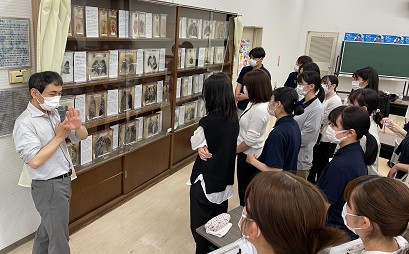
A student receives an explanation about the pathology of tuberculosis in front of a specimen of tuberculous lesions from the whole body in a lecture room at the Tuberculosis Research.
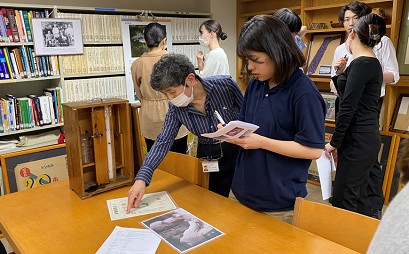
In the library of the Tuberculosis Research, students were seen taking notes while listening to explanations of materials related to tuberculosis.
On the second day, we moved to Kiyose City, Tokyo, where we learned about tuberculosis, which is said to be an "old and new disease," from various perspectives at the "Tuberculosis Research Center" operated by the Japan Society for the Prevention of Tuberculosis. The Research of tuberculosis provides Research training, international cooperation, and the students gave an online lecture the day before the overnight training by Chair Ms. Tomoko Zama of the Health Department of Nursing of the Research Prevention Support Department, and Dr. Susumu Hirao, Director of the Department's Department of Planning and Medicine. Dr. Chair Zama explained the current situation of tuberculosis in Japan and countermeasures, as well as the situation of foreign-born tuberculosis patients, which has been increasing in recent years, and Dr. Hirao explained tuberculosis from the perspective of international health in an easy-to-understand manner.
Based on the knowledge gained from the online lectures, the on-site training deepened the learning about the overview and countermeasures of tuberculosis group infections, specific examples of patient support on a regional basis with hospitals at the core, and the ideal way of supporting tuberculosis patients born abroad. The lecturers were Masaki Ota, Director of the Countermeasures Support Department of the Research, and nurses and social workers from Fukujuji Research (Kiyose City), which is also operated by the Japan Anti-Tuberculosis Association and has a nationally designated advanced tuberculosis facility. We were able to learn from the actual voices of medical professionals about the reality that although the tuberculosis morbidity rate has decreased, the frequency of group infections has not decreased, and the need for multi-disciplinary collaboration and support for the elderly and foreign-born patients, who have a large number of patients, as well as the need for support for the entire community and society.
The two-day training ended with a tour of the library, where materials related to tuberculosis were collected, and a discussion on how to approach young people to gain an understanding of tuberculosis and an awareness of prevention. Participating students said, "I realized again the importance of collaboration and collaboration between different professions. I realized that creating an atmosphere where people can consult with each other is an important role of public health nurses, so that information can be exchanged smoothly. It was an opportunity for each of us to think about the role we should play in the future.